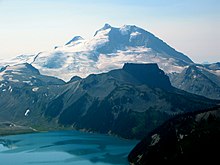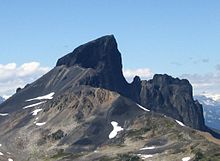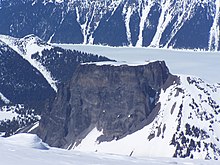Garibaldi Volcanic Belt
The Pemberton Belt began its formation when the former Farallon Plate was subducting under the British Columbia Coast 29 million years ago during the Oligocene epoch.
After this breakup, subduction of the Juan de Fuca Plate might have been coincident with the northern end of Vancouver Island eight million years ago during the late Miocene period.
[19] However, earthquakes along the Cascadia subduction zone are fewer than expected and there is evidence of a decline in volcanic activity over the past few million years.
A possible explanation for the lower rates of volcanism in the Garibaldi chain is that the associated terrain is being compressed in contrast to the more southern portions of the Cascade Arc.
This is likely the case south of Mount Hood to the California border and east-southeast of the massive Newberry shield volcano adjacent to the Cascade Range in central Oregon because the Brothers Fault Zone lies in this region.
They are interpreted to have formed as a result of magma intruding into and melting a vertical hole through adjacent glacial ice that eventually breached the surface of the glacier.
[21] Lava domes that were formed mainly during subglacial activity comprise steep flanks made of intense columnar joints and volcanic glass.
[10] Subsequent volcanism about 9,300 years ago produced a 15 km (9.3 mi) long dacite lava flow from Opal Cone on Garibaldi's southeastern flank.
[29] A series of basaltic andesite flows were erupted from Cinder Cone about 11,000 years ago that traveled into a deep north trending U-shaped valley on the eastern flank of The Black Tusk.
Its volcanics are undated, but its large amount of dissection and evidence of glacial ice overriding the volcano indicates that it formed more than 75,000 years ago before the Wisconsinan Glaciation.
Extensive erosion following the last volcanic event at Mount Fee has created the rugged north–south trending ridge that currently forms a prominent landmark.
[37] This second phase of activity 2.7 ± 0.7 million years ago resulted in the creation of the Vulcan's Thumb, a craggy volcanic ridge on the southern flank of Mount Cayley.
[10] Volcanic activity after this prolonged period of erosion produced thick dacite lava flows from parasitic vents 300,000 years ago that extended into the Turbid and Shovelnose Creek valleys near the Squamish River.
[38] Pali Dome West consists of at least three andesite lava flows and small amounts of pyroclastic material; its vent is presently buried under glacial ice.
These volcanics were extruded about 10,000 years ago during the waning stages of the Fraser Glaciation from a vent adjacent to upper Cauldron Dome that is currently buried under glacial ice.
Lying on the western portion of Slag Hill is a lava flow that likely erupted less than 10,000 years ago due to the lack of features indicating volcano-ice interactions.
The complex is poorly known due to minimal studies, but potassium-argon dates obtained from some of the subvolcanic intrusions indicate that Franklin formed during two volcanic events, each separated by about five million years of dormancy.
[11] The first event occurred between six and eight million years ago when volcanic activity in the Garibaldi Belt had not moved to its current location, but was becoming more aerially restricted within a large band to the east and west.
These volcanoes formed part of the Cascade Volcanic Arc during the Miocene period and their intrusive roots extend from the Fraser Valley in the south to Salal Creek in the north.
Garibaldi Provincial Park at the southern end of the chain was established in 1927 to protect the abundant geological history, glaciated mountains and other natural resources in the region.
[60] However, with the existence of earthquakes, further volcanism is expected and would probably have considerable effects, particularly in a region like southwestern British Columbia where the Garibaldi volcanoes are located in a highly populated area.
[9] Unlike the central Cascade Arc, renewed volcanic activity in the Garibaldi Belt at a single feeder to create stratovolcanoes is not typical.
However, considerable volcanic activity has taken place in the geologically recent past, most notably the explosive eruption that occurred at the Mount Meager massif 2,350 years ago.
[20] Jack Souther, a leading authority on geothermal resources and volcanism in the Canadian Cordillera has stated, "at present the volcanoes of the Garibaldi Belt are quiet, presumed dead but still not completely cold.
So just in case I sometimes do a quick check of the old hot-spots when I get off the Peak Chair ..."[61] Recent seismic imaging from Geological Survey of Canada employees supported lithoprobe studies in the region of Mount Cayley in which scientists found a large reflector interpreted to be a pool of molten rock roughly 15 km (9.3 mi) below the surface.
[20] Mount Meager massif in particular poses a major long-distance threat to communities throughout southern British Columbia and Alberta because of its explosive history.
However, all major cities in southwestern British Columbia with populations more than 100,000 are located west of the Garibaldi Volcanic Belt and prevailing winds travel eastwards.
[20] Even though all major cities in southwestern British Columbia are located west of the Garibaldi chain, future eruptions are expected to have significant impacts on the adjacent townships of Squamish and Whistler.
At least two significant landslides from the southern flank of Pylon Peak 8,700 and 4,400 years ago dumped volcanic debris into the adjacent valley of Meager Creek.
[46] Large landslides from Mount Cayley have occurred on its western flank, including a major debris avalanche about 4,800 years ago that dumped an areal extent of 8 km2 (3.1 sq mi) of volcanic material into the adjacent valley bottom.











